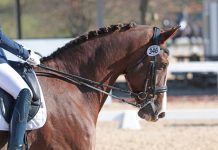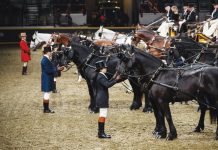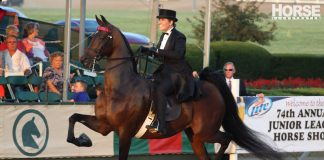
Ellen Beard has trained American Saddlebreds and saddle seat equitation riders for more than 30 years. She is currently the assistant professor and coordinator of equestrian operations at Stephens College in Columbia, Mo. Beard emphasizes that in order to understand saddle seat equitation, you must first understand the function of the horse in that discipline.
“The saddle seat horse moves vertically as well as horizontally, and because of that, the rider ends up being more in the middle of the horse’s back,” explains Beard. “These horses have a very upright neck and high head carriage. The way they move off their hocks is a more vertical motion than in other types of horses. That lends itself to the rider having a very upright position.”
The cutback saddles used in saddle seat riding are flatter than other English saddles, so you need to center yourself comfortably in the seat. Adjust your stirrups so that the bottom of the stirrup iron hits your ankle bone when you let your leg hang. If your stirrups are adjusted correctly and your saddle is the right size, there will be an inch or two between your seat and the cantle.
Keep your shoulders back so you aren’t collapsing forward on your horse, but be careful not to lean back. Maintaining a neutral, vertical position in the saddle will allow you to balance properly and move in sync with your horse.
“You need to be in the center of your horse’s back to stay with his motion,” says Beard. “If you’re ahead of or behind your horse’s motion, you’re going to become unbalanced.”
Legs and Feet
One of the most common misconceptions of saddle seat riding is that the riders are supposed to push their feet out in front of them. Attend any saddle seat breed horse show and it’s not hard to see why this perception is so widespread. Many trainers ride with their legs slightly ahead of the vertical, especially when mounted on high-energy performance horses, but it’s not correct equitation and doesn’t create a pretty picture.
When viewed from the side, there should be a straight line that runs perpendicular to the ground from your ear through your shoulder and hip to your heel. This position is necessary for balance. If your leg is too far behind you, it will cause your upper body to lean forward. If it’s too far in front, you will not be able to post with the motion of your horse. Think of the joints in your lower body as shock absorbers; they need to remain in line and be fluid, not stiff, to be effective.
“All of the joints in the rider’s leg must be able to flex,” explains Beard. “If you brace against your stirrups, you’ll pop off your horse’s back. The best equitation riders are those who can absorb their horse’s animation and still create a pleasant picture.”
Riders coming to saddle seat from other disciplines often have the most trouble with lower leg position. Instead of the constant lower leg contact favored in hunt seat and dressage, your calves should be slightly away from your horse’s sides. Beard explains that this difference in position comes from the difference in horses used for saddle seat riding.
Saddle seat breeds, particularly Saddlebreds, are highly sensitive and require a sensitive leg.
“Saddlebreds are very thin-skinned, more so than most other breeds,” explains Beard. “We use our leg cues as needed, and then remove them. When you drive a high-powered sports car, you don’t just lay on the gas pedal; you use it intermittently, as needed. We ride our high-powered horses the same way.”
Beard also cites the saddle-type horses’ historical use as part of the reason for their sensitivity and forward- going nature. Both Saddlebreds and Morgans, for example, were historically bred to be cavalry mounts.
“These horses were bred to trot across the battlefield and to go past anything that’s scary,” she says. The result is that today’s descendants of those war horses are forward- moving by nature and don’t need the driving leg and seat aids used in other disciplines.
To position your leg correctly, you need to maintain contact with your knees and thighs. Place your foot in the stirrup so you have even pressure across the ball of your foot, with your toes pointing straight ahead. With this proper foot position, your leg will fall correctly into place. Pinching with your knees and thighs will create a tense, stiff position. Instead, think of resting your upper legs against the saddle.
Hand Position
The United States Equestrian Federation rule book specifies that “the height the hands are held above the horse’s withers is a matter of how and where the horse carries his head.” The rider’s hands should remain at the same level as the horse’s mouth so the snaffle rein on the double bridle stays parallel to the ground.

Hand position is a dynamic element of equitation. When mounted on a horse with a long neck and high head carriage, you will need to hold your hands higher. A horse with a shorter neck will require a lower hand position, and this is where some saddle seat riders get into trouble. Many top equitation riders are mounted on very upheaded American Saddlebreds. This creates the idea that a very high hand position is the ideal, when in reality, such an exaggerated position is incorrect on a horse with a shorter neck or lower head carriage.
“Your position is only as good as it communicates to your horse,” says Beard. “A direct line from your snaffle bit to your elbow is the most efficient line of communication.”
Additionally, the hands’ position is secondary to their use. Like all English disciplines, saddle seat demands contact, but you shouldn’t be trying to pull your horse into a frame with the reins. Your contact should be sympathetic and elastic, not forceful. In every element of saddle seat equitation, think of how it affects your horse. Keep your position in tune with him, and you’ll present a winning picture every time.
Liked this article? Here are others on saddle seat riding:
Fresh Steps: Create an at-home saddle seat training routine
Saddle Seat Myths and Misconceptions
This article originally appeared in the March 2011 issue of Horse Illustrated. Click here to subscribe.






I rode gaited horses and some Tennesse Walkers, showed some as an amateur. Was from Missouri. If your magazine had more articles on equitation and saddlebreds in general, I would send money for a subscription. Too many pictures of horses in fields.
I’m going into equitation this year, and I was just wondering if anyone could tell me any shows that have pattern classes in the ohio , Kentucky , Indiana area.
Thanks
Thanks
I agree with Constance. I have an Arabian/Saddlebred and an Arabian. Part of the reason I don’t get this magazine anymore is because the English section of the magazine seems to be geared only to hunter, jumper, or eventing. Very rarely is something that is geared toward Arabians, Saddlebreds, and/or Morgans show up in the magazine. If those articles appeared more I would subscribe again to this magazine.
The key to learning proper saddle seat equitation is to TAKE IT SLOW. The small nuanced positioning and balance tips you lay out take a lot of time to learn properly! http://thejodhpurscompany.com/blogs/the-jodhpurs-company-blog/19144511-three-signs-that-equitation-may-not-be-right-for-you